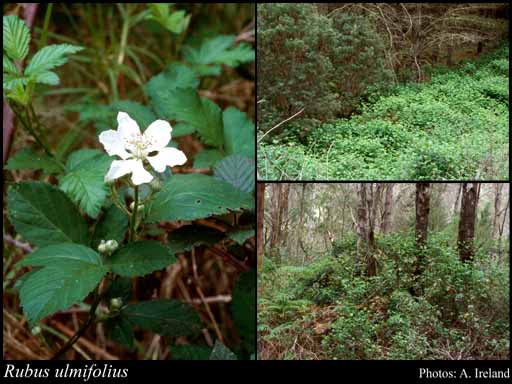- Reference
- Isis (Oken) 1818:821 (1818)
- Conservation Code
- Not threatened
- Naturalised Status
- Alien to Western Australia
- Name Status
- Current
Straggling perennial, herb or shrub, to 4 m high. Fl. pink/white/blue/purple, Nov to Dec or Jan. Along creeks & drains.

Distribution
- IBRA Regions
- Jarrah Forest, Swan Coastal Plain, Warren.
- IBRA Subregions
- Northern Jarrah Forest, Perth, Southern Jarrah Forest, Warren.
- IMCRA Regions
- WA South Coast.
- Local Government Areas (LGAs)
- Albany, Bridgetown-Greenbushes, Donnybrook-Balingup, Harvey, Kalamunda, Manjimup, Mundaring, Serpentine-Jarrahdale.
Management Notes (for the Swan NRM Region)
Alternative Names. Elm-leaf blackberry.
General Biology. Growth form. Shrub. Reproduction. Seed, stem layering, suckering. Dispersal. Birds, foxes, other mammals, garden refuse. Vegetative regeneration strategy. Resprouts, produces root suckers, stem layering. Seedbank persistence. Unknown for this species, however seed dormancy and vaiblility is highly variable within Rubus, all species have some dormancy. Fire response. Resprouts following fire.
Notes. In 2004/2005 herbarium collections of blackberry were made across the state as part of a NRM project to determine the overall distribution and incidence of weedy blackberry taxa. It identified WA has several weedy Rubus species, with no native Rubus species. Also naturalized in south west Asia, North and South America, South Africa, New Zealand and Polynesia. For further information on identification refer to Barker and Barker (2005) Blackberry: an identification tool to introduced & native Rubus in Australia [CD-ROM] or CSIRO (2005) Field guide for the identification of WA blackberry. R. ulmifolius occurs in isolated patches throughout the southwest of the State and is the main species in the Perth Metropolitan Area. There are also incursions near Harvey, Collie and Pemberton. At one site near Perth it co-occurs with R. laudatus and R. anglocandicans, indicating the ability of all three species to colonise the same habitat. Pollinated by bees. Has reported high levels of non-viable seeds, however this is counteracted by high rates of seed production. Germination triggered by soil disturbance.
Additional information. Origin. Northern Africa, Europe. History of use/introduction. Garden/farm escape, ornamental. Similar exotic species. R. anglocandicans, R. laudatus.
Suggested method of management and control. Spray with metsulfuron methyl 1 g/10 L + the wetting agent Endose® at 30 ml/10 L, in summer-autumn. Will require follow up for a number of years. For small infestations or in sensitive areas hand pull small plants or seedlings. For larger plants cut and paint with 20-50% glyphosate or slash canes. Spray regrowth at 50cm with metsulfuron methyl 1 g/10 L + the wetting agent Endose® at 30 ml/10 L, in summer-autumn. Read the manufacturers' labels and material safety data sheets before using herbicides. For further information consult the Australian Pesticides and Veterinary Medicines Authority to determine the status of permits for your situation or state.
Management Calendar
| Calendar Type | Jan | Feb | Mar | Apr | May | Jun | Jul | Aug | Sep | Oct | Nov | Dec | Comments |
|---|---|---|---|---|---|---|---|---|---|---|---|---|---|
| Dormant | Y | Y | Y | ||||||||||
| Active Growth | Y | Y | O | Y | Y | Y | |||||||
| Flowering | Y | Y | Y | ||||||||||
| Fruiting | Y | Y | Y | U | |||||||||
| Optimum Treatment | Y | Y | O | Y |
Legend: Y = Yes, regularly, O = Occasionally, U = Uncertain, referred by others but not confirmed.
References
- Barker, R.M. & Barker, W.R. (2005) Blackberry: an identification tool to introduced and native Rubus in Australia. Edn 1.00. State Herbarium of South Australia, Adelaide.
- Botanic Gardens Trust (2009) Ecology of Cumberland Plain Woodland, Woodland Plants - Rubus ulmifolius. Department of Environment, Climate Change and Water NSW, Sydney, NSW. URL: http://www.rbgsyd.nsw.gov.au/science/current_research/Ecology_of_Cumberland_Plain_Woodland/woodland_plants/rubus_fruiticosus - Accessed October 2009.
- Brown, K. & Brooks, K. (2002) Bushland Weeds: A Practical Guide to their Management. Environmental Weeds Action Network, Greenwood.
- CRC Weed Management (2003) Weeds of National Significance, Weed Management Guide, Blackberry - Rubus fruticosus aggregate. Department of Environment and Heritage.
- Environment Waikato (2009) Environment Waikato pest guide - section 4. URL: http://www.ew.govt.nz/Environmental-information/Plant-and-animal-pests/Plant-pests/#Heading3 - Accessed November 2009.
- Hussey, B.M.J., Keighery, G.J., Dodd, J., Lloyd, S.G. & Cousens, R.D. (2007) Western Weeds. A guide to the weeds of Western Australia. 2nd Edition. The Plant Protection Society of Western Australia, Victoria Park.
- USDA, ARS, National Genetic Resources Program (2009) Germplasm Resources Information Network - (GRIN). National Germplasm Resources Laboratory, Beltsville, Maryland. URL: https://npgsweb.ars-grin.gov/gringlobal/taxon/taxonomysimple.aspx - Accessed October 2009.
- Yeoh, P.B., Scott, J.K., Batchelor, K.L., Morin, L., Fontanini, L., McFarlane, T.D., Wilson, I.J, Moore, J.H., Merks, P.F. & Taylor, M. (2006) Weedy blackberry and raspberry species in Western Australia and strategies for their management (Draft). CSIRO.
- Zasada, J.C. & Tappeiner, J.C. (2002) Rosaceae-Rose family, Rubus L. The National Seed Laboratory, USDA Forest Service URL: http://www.nsl.fs.fed.us/wpsm/Rubus.pdf - Accessed October 2009.